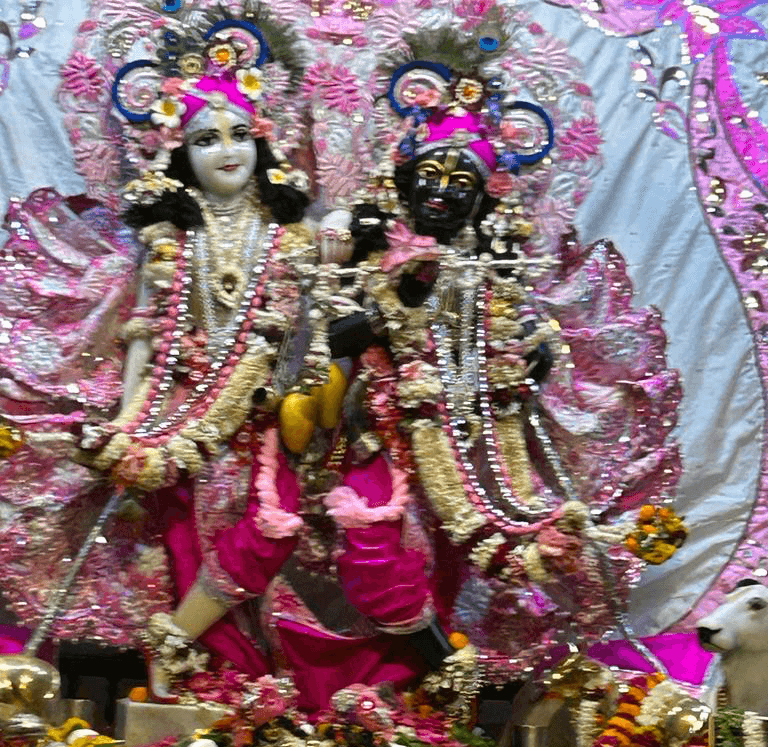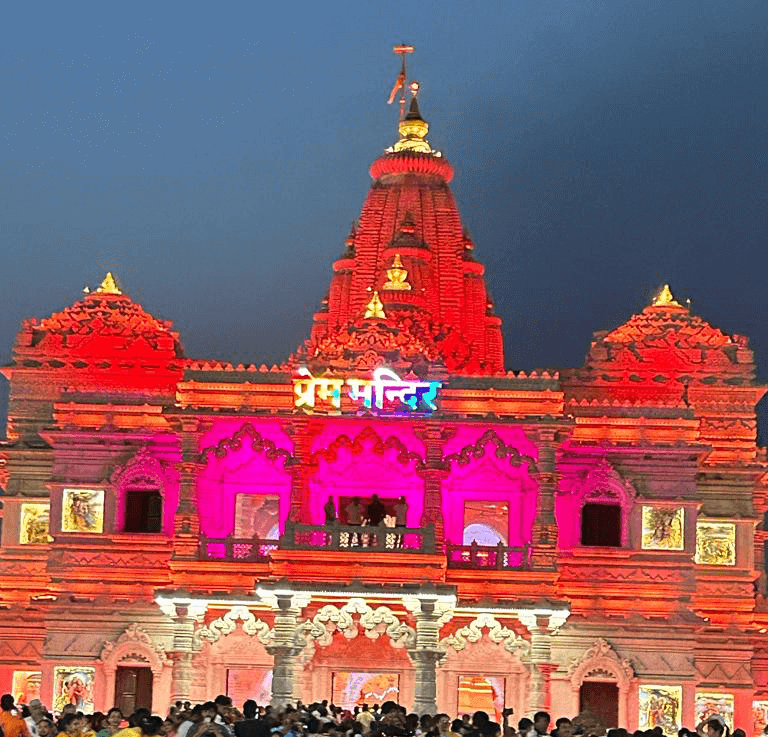In Vrindavan, the soul awakens to eternal longing for Krishna’s love, leading to a sacred pilgrimage, confides Dr Roopali, exclusively for Different Truths.

At a classical music concert not long ago, Maestro Padma Vibhushan Sajan Misra concluded the evening with a bhajan, “Chalo Mann Vrindavan ki or.”
I was hearing it for the first time. And in the voice of the great artist himself. This bhajan was penned by Narayan Agarwal in 2014, inspired by the famous 12th-century Meera Bai bhajan, “Chalo Mann Ganga Jamuna Teer.”
As he sang with ardent devotion, I felt the song seep deep into my very being. Its lyrics were calling upon my heart and mind, “Chalo Mann Vrindavan ki or.” (O, my beating heart, take me to Vrindavan.) Like a harp, my heartstrings began to sing.
It was as if divine fingers had touched me. Soon, the song transformed itself into a longing. My soul began to pull me toward Vrindavan.
I completely longed for Vrindavan.
I completely longed for Vrindavan. I had often heard people say they couldn’t embark on a pilgrimage because they hadn’t “received the call.” I’d always dismissed that as an excuse. But now I felt beckoned. I knew I had to go. I must go to Vrindavan!
Vrindavan is situated on the banks of the Yamuna, about two hundred kilometers from Delhi. Soaked in history and the legends and myths of Lord Krishna, it is a city that is part of the collective consciousness of the people of India.
Lord Krishna is a pan-Indian deity, known not just to Hindus, but to people of other faith traditions as well. He is homegrown. He is dark-complexioned. He is a commoner, not a king. Sufi songs sing of Krishna unhesitatingly. He is the epitome of love, and love is the hallmark of all faiths.
Unlike the Abrahamic faiths, Hinduism is pantheistic. It assumes that as human beings, we are different, and different people naturally need different pathways to the divine. So, Hindus worship the divine in millions of different forms, reflecting its infinite aspects. The deities in the Indian pantheon are also region-based.
Only Krishna is worshipped everywhere in India. He is celebrated in dance and music, songs and drama…
Only Krishna is worshipped everywhere in India. He is celebrated in dance and music, songs and drama, sculpture and art, and paintings, poetry, and murals.
For Hindus, Krishna is the voice of the Bhagavad Gita. It is he who lays down the ethics by which we Hindus live our lives. It is he who calls Arjuna to the battlefield—a reminder for us to fulfil our divine duty—our Dharm.


He is Arjun’s humble charioteer and strategist who leads him into a victorious battle, he is the cowherd and the loving friend of poor Sudama. He protects Draupadi’s honour in the presence of her five husbands and the mighty Kauravas.
But most of all, he is known as Makhan Chor—the butter thief, the naughty child of mother Yashoda. His stunning childlike wisdom reveals his divinity.
Legend has it that Krishna was born in Mathura, 14 miles away from Vrindavan. It was a rainy, stormy monsoon night. His birth is fraught with danger and violence. A prophecy foretold that Krishna’s maternal uncle Kansa, the usurper to the throne of Mathura, would perish at the hands of his sister Devaki’s eighth-born son. He threw Devaki into the dungeon to kill Krishna, the eighth born, but failed.
The Krishna Janma Bhoomi temple complex, the birthplace of Lord Krishna in Mathura, was built in the 6th century BC. When we visited, we found heavy security around the premises that did not permit photography. This is due to the controversial mosque, Shahi Idgah, nearby. This was built by Mughal Emperor Aurangzeb, in 1669.
Our entry into the dungeon cell where Krishna is said to have been born was nothing less than cathartic.
Our entry into the dungeon cell where Krishna is said to have been born was nothing less than cathartic. A sense of being in the antiquated past filled us, and we were as if hemlock drunk. The journey had begun. One that was to make us experience a joyous celebration of the oneness of the body and the soul with the oversoul.
Mathura and Vrindavan are twin cities. Here, no less than 5,000 temples await you. All celebrating Krishna and his beloved Radha. Love is the key to Krishna’s heart. Radha and he are soulmates. Poet Jaidev’s Geet Govinda celebrates the love between Radha and Krishna.
Nidhivan is one of the sacred sites in Vrindavan. It is a forest comprised almost entirely of “Tulsi” Holy Basil plants and is the most prominent site dedicated to the pastimes of Radha and Krishna and their companion milkmaids (Gopis).
Besides Tulsi plants, the premises also houses a temple called Rang Mahal, where it is believed that Radha and Krishna spend their night after the raaslila dance ritual.
It is a common belief among devotees that Nidhivan still witnesses the raaslila of the deities during the nighttime.
It is a common belief among devotees that Nidhivan still witnesses the raaslila of the deities during the nighttime. Therefore, nobody is allowed overnight visits to Nidhivan. As evening falls, the temple is padlocked with eight locks. It is believed that peeping toms will find themselves blinded!


The next morning, we visited ISKCON Vrindavan, also called Sri Sri Krishna Balaram Mandir. It is one of the major ISKCON temples in the world, with its sprawling precincts and complete immersion in Radha Krishna mysticism. Marble statues of Radha and Krishna dressed in opulent satins and brocade are a hallmark of ISKCON temples all over the world.
Krishna is an experience.
Krishna is an experience. Young women in long skirts dressed like Radha’s milkmaid friends can walk about or dance with gay abandon. The ISKCON “Hare Krishna” sect, or cult, depending on who you ask, attracts large numbers of devotees from Russia, the United Kingdom, Europe, and the United States. Coming from stoic and puritanic beliefs, the vibrant, celebratory nature of Krishna worship is the primary appealing factor.
In the temple compound, bakeries and eateries serve pure vegetarian delights. Stores selling clothes and illustrated copies of the Bhagavad Gita abound. The air is imbued with a sense of spirituality and ecstasy. Of being in the presence and company of Krishna – the divine lover.
When we visited, it was the auspicious day of Ekadashi. This is the eleventh lunar day of the waxing and waning lunar cycles in the Vedic calendar month. Followers offer their worship to the god Vishnu by fasting. Krishna is considered an avatar of Vishnu.
Crowds milled around pushing and jostling. But for our military escort Sergeant Vijay Kumar, we would not have been able to enter any temple easily. A resident of the holy city, he knew every stubborn arrogant priest or guard. We found ourselves close to being cradled by Krishna himself.
In Vrindavan, the Banke Bihari temple is the most visited.
In Vrindavan, the Banke Bihari temple is the most visited. The temple is dedicated to Banke Bihari, who is believed to be the combined form of Radha and Krishna. Here, the icon of Radha Krishna’s united form stands in the Tribhanga posture. This is a standing body stance used in traditional Indian art and Indian classical dance. Here, the body bends in one direction at the knees, in the other direction at the hips, and then again at the shoulders and neck. The tribhanga is accentuated by gender differences at the hips and shoulders.
It’s not just the temples, sweets abound in Vrindavan. Milky, sweet rabri, peda, lassi, savoury poori, parathas, and potato curry are at every corner. The five senses find home here in Vrindavan.
The Dwarka Dheesh temple is a must-visit at the crack of dawn! Originally built 2500 years ago, and later destroyed by Mughal raiders, it is now a colourful temple built in the Rajasthani Marwari style. It is dedicated to Krishna as king of Dwarka. Its present structure was built in 1814 by Seth Gokul Das Parekh.
The vast Yamuna flows fast in the background. The temple bells were ringing. Vrindavan wakes to a Krishna dawn. It is here that the sun rises on the banks of the Yamuna River with the chant of Sri Krishna’s name. “Jahan Krishna naam se bhor huey.” This is what Sajan Misraji sang. This is what I wanted so much to experience.
It brought to mind Wordsworth’s Bliss: It was in that dawn to be alive; to be young was very heaven.” Only here in Vrindavan, you are forever young. Immortality is granted to you here. Your joyous soul is Krishna, the young lover. You are the dancer and the dance. The eternal flute plays endlessly. Mesmerising creatures, great and small.
The Prem Mandir, a not-so-long-ago temple, attracts crowds of people. It has a kind of disco environment.
The Prem Mandir, a not-so-long-ago temple, attracts crowds of people. It has a kind of disco environment. The Raasleela dance of Radha and Krishna and their milkmaids. Continuity from the past to the present. Nothing is incongruous. With its sound and multi-coloured light show, the temple creates a colourful celebration every evening.
We had travelled both physically and spiritually. From Krishna’s birthplace temple in Mathura frozen in antiquity to Vrindavan’s mystic Nidhi Van to the tech-savvy Prem Mandir.
Like Radha, we now wait with love and longing for Krishna. Vrindavan is no longer a place. It’s a soul feeling.
Photos by the author






 By
By
 By
By

Very nice post – experienced everything with the writer
Thank you so much for sharing this spiritual experience in such delightful prose!
Beautiful travelogue. I visited Vrindavan – Mathura through you Roopali.
Read this today and am very grateful to you for sending me the link to it. I had forgotten about it, but as if by Krishna’s will it came up accidently again yesterday. I totally agree with you. Krishna is an experience, a consciousness. Once he takes hold of one’s heart and soul he doesn’t let it go.